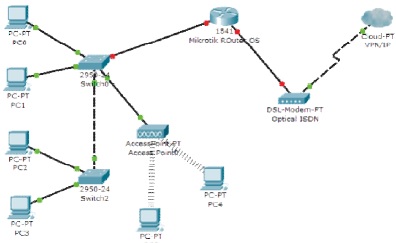Manajemen Bandwidth Berdasarkan Prediksi Perilaku Pengguna Pada Jaringan TCP/IP Dengan Jaringan Syaraf Tiruan
Abstract
User behavior prediction on TCP / IP networks is very possible because each data packet is passed through a router that can be analyzed and then classified into several behavior types from commonly performed activities by internet users. User-behavior predictions developed using artificial neural networks (ANN), which can show accurate results in predicting the bandwidth used by users in the next few days. Predicting results helps network administrators to provide a more accurate picture of user behavior patterns in the future, where the Personnel Service Application System (SAPK) which becomes the user behavior internet priority it's only utilized network resources at 26.8% of the total internet network resources available. The ANN that was developed also showed that 40.3% of network resources were used more by streaming video activities and 37% were used for streaming audio activities. With the prediction result, the network administrator rearranges the internet network resources distribution by applying a new prediction results pattern. This study conclusively shows that user behavior with streaming video activities is the largest bandwidth user and needs to get special attention on the internet network at the Regional X National Civil Service Agency Office.
Downloads
References
[2] M. Hemmati, B. McCormick, and S. Shirmohammadi, “Fair and Efficient Bandwidth Allocation for Video Flows Using Sigmoidal Programming,” in 2016 IEEE International Symposium on Multimedia (ISM), Dec. 2016, pp. 226–231, doi: 10.1109/ISM.2016.0052.
[3] M. Amiri, H. Al Osman, and S. Shirmohammadi, “Game-aware bandwidth allocation for home gateways,” in 2017 15th Annual Workshop on Network and Systems Support for Games (NetGames), Jun. 2017, pp. 1–3, doi: 10.1109/NetGames.2017.7991546.
[4] A. Badea, V. Croitoru, and D. Gheorghică, “Computer networks security based on the detection of user’s behavior,” in 2015 9th International Symposium on Advanced Topics in Electrical Engineering (ATEE), May 2015, pp. 55–60, doi: 10.1109/ATEE.2015.7133679.
[5] B. Leng, J. Liu, H. Pan, S. Zhou, and Z. Niu, “Topic model based behaviour modeling and clustering analysis for wireless network users,” in 2015 21st Asia-Pacific Conference on Communications (APCC), Oct. 2015, pp. 410–415, doi: 10.1109/APCC.2015.7412547.
[6] A. Sinha, K. Mitchell, and D. Medhi, “Flow-level upstream traffic behavior in broadband access networks: DSL versus broadband fixed wireless,” Nov. 2003, pp. 135–141, doi: 10.1109/IPOM.2003.1251235.
[7] H. Marques-Neto, L. Rocha, P. Guerra, J. Almeida, W. Meira Jr, and V. Almeida, “Characterizing broadband user behavior,” Nov. 2004, doi: 10.1145/1026763.1026767.
[8] J. Ma and Y. Zhang, “Research on Trusted Evaluation Method of User Behavior Based on AHP Algorithm,” in 2015 7th International Conference on Information Technology in Medicine and Education (ITME), Nov. 2015, pp. 588–592, doi: 10.1109/ITME.2015.39.
[9] H. Harsono, M. Khambali, and A. W. Muhammad, “Klasifikasi Paket Jaringan Berbasis Analisis Statistik dan Neural Network,” J. Inform. J. Pengemb. IT, vol. 3, no. 1, pp. 67–70, Jan. 2018, doi: 10.30591/jpit.v3i1.764.
[10] Suyanto, DATA Mining untuk Klasifikasi dan Klasterisasi, 1st ed., vol. Cet. 1. Bandung: INFORMATIKA Bandung, 2017.
[11] B. Santosa, “Data mining teknik pemanfaatan data untuk keperluan bisnis,” Yogyak. Graha Ilmu, vol. 978, no. 979, p. 756, 2007.
[12] N. A. Al-Sammarraie, Y. M. H. Al-Mayali, and Y. A. Baker El-Ebiary, “Classification and diagnosis using back propagation Artificial Neural Networks (ANN),” in 2018 International Conference on Smart Computing and Electronic Enterprise (ICSCEE), Jul. 2018, pp. 1–5, doi: 10.1109/ICSCEE.2018.8538383.
[13] A. Hasim, “Prakiraan Beban Listrik Kota Pontianak Dengan Jaringan Syaraf Tiruan (Artificial Neural Network),” 2008, Accessed: Sep. 02, 2019 [Online]. Available: http://repository.ipb.ac.id/handle/123456789/41400.
[14] W. Setiawan and S. A. Asri, “APLIKASI JARINGAN SYARAF TIRUAN PERAMBATAN BALIK PADA PENGENALAN ANGKA TULISAN TANGAN,” Maj. Ilm. Teknol. Elektro, vol. 4, no. 2, Jul. 2005, Accessed: Jul. 12, 2019. [Online]. Available: https://ojs.unud.ac.id/index.php/JTE/article/view/209.
[15] “RegexOne - Learn Regular Expressions - Lesson 1: An Introduction, and the ABCs.” https://regexone.com/ (accessed Sep. 11, 2019).


This work is licensed under a Creative Commons Attribution-NonCommercial-NoDerivatives 4.0 International License.

This work is licensed under a Creative Commons Attribution 4.0 International License




